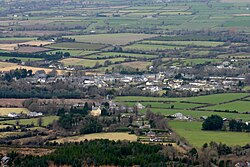Clogheen, County Tipperary
|
Clogheen Chloichín an Mhargaid
|
|
|---|---|
| Village | |

Clogheen seen from the Knockmealdown Mountains
|
|
| Location in Ireland | |
| Coordinates: 52°16′34″N 7°59′46″W / 52.276°N 7.996°WCoordinates: 52°16′34″N 7°59′46″W / 52.276°N 7.996°W | |
| Country | Ireland |
| Province | Munster |
| County | County Tipperary |
| Dáil Éireann | Tipperary South |
| Elevation | 54 m (177 ft) |
| Population (2006) | |
| • Total | 509 |
| Dialing code | 0 52, +000 353 (0)52 |
| Irish Grid Reference | S001137 |
| Website | clogheen |
Clogheen (Irish: Chloichín an Mhargaid, meaning "Little Stone of the Market") is a village in County Tipperary, Ireland. The census of 2006 recorded the population at 509 people.
It lies in the Galtee-Vee Valley with the Galtee Mountains to the north and the Knockmealdowns in close proximity to the south. The River Tar which is a tributary of the Suir runs through the village. It is located on the R665 and R668 regional roads. The nearest large towns are Cahir and Mitchelstown, approximately 14 and 20 kilometres away, respectively.
During the week it is served five times a day in each direction by Bus Éireann route 245 linking it to Clonmel, Mitchelstown, Fermoy and Cork. At the weekend there are three buses each way.
The first substantial records of the village date from the Cromwellian period, but the village did not come to note until the 18th and 19th centuries. It then became a local centre of trade and commerce. The village takes its modern form from the 19th century with a wide area that was formerly the Market Square (and still named so) and a number of townhouses in the Georgian style. Evidence of its former economic activity exists in the form of a number of ruined mills and accompanying mill-streams in the environs of the village, as well as several large estates.
A former Catholic parish priest of Clogheen, Nicholas Sheehy, is buried at Shanrahan graveyard just outside the village, having been executed in 1766. Sheehy had been a vocal opponent of Anglican Church tithes. When a secret oath-bound society known as the Whiteboys, formed in the parish, elements of the Protestant Ascendancy conspired to make him an example to those who questioned or threatened their powers. After a kangaroo trial in Clonmel, he was hung for murder and treason, crimes with little basis, no reliable witnesses, and no proof.
...
Wikipedia

